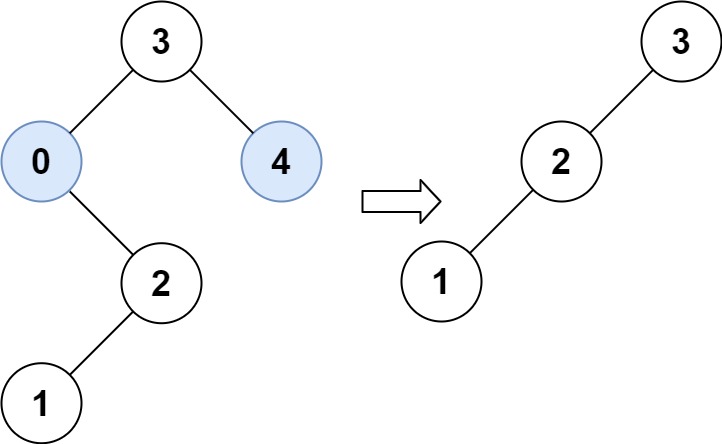本文最后更新于:2022年4月9日 中午
给你二叉搜索树的根节点 root ,同时给定最小边界low 和最大边界 high。通过修剪二叉搜索树,使得所有节点的值在[low, high]中。修剪树不应该改变保留在树中的元素的相对结构(即,如果没有被移除,原有的父代子代关系都应当保留)。 可以证明,存在唯一的答案。
所以结果应当返回修剪好的二叉搜索树的新的根节点。注意,根节点可能会根据给定的边界发生改变。
示例 1:

| 输入:root = [1,0,2], low = 1, high = 2
输出:[1,null,2]
|
示例 2:

| 输入:root = [3,0,4,null,2,null,null,1], low = 1, high = 3
输出:[3,2,null,1]
|
示例 3:
| 输入:root = [1], low = 1, high = 2
输出:[1]
|
示例 4:
| 输入:root = [1,null,2], low = 1, high = 3
输出:[1,null,2]
|
示例 5:
| 输入:root = [1,null,2], low = 2, high = 4
输出:[2]
|
提示:
- 树中节点数在范围
[1, 104] 内
0 <= Node.val <= 104- 树中每个节点的值都是唯一的
- 题目数据保证输入是一棵有效的二叉搜索树
0 <= low <= high <= 104
Solution
参考 代码随想录
- 递归法
- 确定递归函数的参数以及返回值
- 确定终止条件
- 确定单层递归的逻辑
1
2
3
4
5
6
7
8
9
10
11
12
13
14
15
16
17
18
19
20
21
22
23
24
25
|
class Solution {
public:
TreeNode* trimBST(TreeNode* root, int low, int high) {
if (root == nullptr) return nullptr;
if (root->val < low) return trimBST(root->right, low, high);
if (root->val > high) return trimBST(root->left, low, high);
root->left = trimBST(root->left, low, high);
root->right = trimBST(root->right, low, high);
return root;
}
};
|
1
2
3
4
5
6
7
8
9
10
11
12
13
14
15
16
17
18
19
20
21
22
23
24
25
26
27
28
29
30
31
| class Solution {
public:
TreeNode* trimBST(TreeNode* root, int low, int high) {
if (root == nullptr) return root;
while (root && (root->val < low || root->val > high)) {
if (root->val < low) root = root->right;
else root = root->left;
}
TreeNode* cur = root;
while (cur != nullptr) {
while (cur->left && cur->left->val < low) {
cur->left = cur->left->right;
}
cur = cur->left;
}
cur = root;
while (cur != nullptr) {
while (cur->right && cur->right->val > high) {
cur->right = cur->right->left;
}
cur = cur->right;
}
return root;
}
};
|

